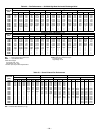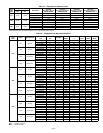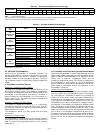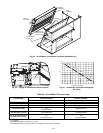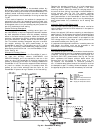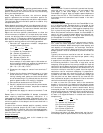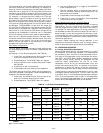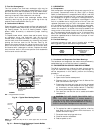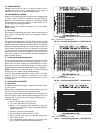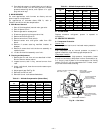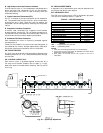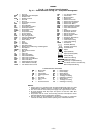
—36—
B. Heating, Units Without Economizer
NOTE: The 581A210-300 units have 2 stages of electric heat.
When the thermostat calls for heating, power is sent to W on
the IGC (integrated gas unit controller) board. An LED
(light-emitting diode) on the IGC board will be on during
normal operation. A check is made to ensure that the rollout
switch and limit switch are closed and the induced-draft
motor is running. The induced-draft motor is then energized,
and when speed is proven with the hall effect sensor on the
motor, the ignition activation period begins. The burners will
ignite within 5 seconds.
If the burners do not light, there is a 22-second delay before
another 5-second attempt. If the burners still do not light,
this sequence is repeated for 15 minutes. After the 15 min-
utes have elapsed, if the burners still have not lit, heating
is locked out. To reset the control, break 24-v power to the
thermostat.
When ignition occurs the IGC board will continue to monitor
the condition of the rollout and limit switches, the hall effect
sensor, as well as the flame sensor. If the unit is controlled
through a room thermostat set for fan auto., 45 seconds after
ignition occurs, the indoor-fan motor will be energized (and
the outdoor-air dampers will open to their minimum posi-
tion). If for some reason the overtemperature limit opens
prior to the start of the indoor fan blower, on the next
attempt, the 45-second delay will be shortened to 5 seconds
less than the time from initiation of heat to when the limit
tripped. Gas will not be interrupted to the burners and heat-
ing will continue. Once modified, the fan on delay will not
change back to 45 seconds unless power is reset to the
control.
When additional heat is required, W2 closes and initiates
power to the second stage of the main gas valve. When the
thermostat is satisfied, W1 and W2 open and the gas valve
closes, interrupting the flow of gas to the main burners. If
the call for W1 lasted less than 1 minute, the heating cycle
will not terminate until 1 minute after W1 became active. If
the unit is controlled through a room thermostat set for fan
auto., the indoor-fan motor will continue to operate for an
additional 45 seconds then stop (and the outdoor-air damp-
ers will close). If the overtemperature limit opens after the
indoor motor is stopped within 10 minutes of W1 becoming
inactive, on the next cycle the time will be extended by
15 seconds. The maximum delay is 3 minutes. Once modi-
fied, the fan off delay will not change back to 45 seconds
unless power is reset to the control.
A LED indicator is provided on the IGC to monitor opera-
tion. The IGC is located by removing the side panel and
viewing the IGC through the view port located in the control
box access panel. During normal operation, the LED is con-
tinuously on. For information on troubleshooting refer to
page 47.
C. Cooling, Units With EconoMi$er IV
When free cooling is not available, the compressors will be
controlled by the zone thermostat. When free cooling is avail-
able, the outdoor-air damper is modulated by the EconoMi$er
IV control to provide a 50 to 55 F supply-air temperature into
the zone. As the supply-air temperature fluctuates above 55 or
below 50 F, the dampers will be modulated (open or close) to
bring the supply-air temperature back within the set points.
Integrated EconoMi$er IV operation on single-stage units
requires a 2-stage thermostat (Y1 and Y2).
For EconoMi$er IV operation, there must be a thermostat
call for the fan (G). This will move the damper to its mini-
mum position during the occupied mode.
Above 50 F supply-air temperature, the dampers will modu-
late from 100% open to the minimum open position. From
50 F to 45 F supply-air temperature, the dampers will main-
tain at the minimum open position. Below 45 F the dampers
will be completely shut. As the supply-air temperature rises,
the dampers will come back open to the minimum open posi-
tion once the supply-air temperature rises to 48 F.
If optional power exhaust is installed, as the outdoor-air
damper opens and closes, the power exhaust fans will be
energized and deenergized.
If field-installed accessory CO
2
sensors are connected to the
EconoMi$er IV control, a demand controlled ventilation
strategy will begin to operate. As the CO
2
level in the zone
increases above the CO
2
set point, the minimum position of
the damper will be increased proportionally. As the CO
2
level
decreases because of the increase in fresh air, the outdoor-air
damper will be proportionally closed. Damper position will
follow the higher demand condition from DCV mode or free
cooling mode.
Damper movement from full closed to full open (or vice
versa) will take between 1
1
/
2
and 2
1
/
2
minutes.
If free cooling can be used as determined from the appropri-
ate changeover command (switch, dry bulb, enthalpy curve,
differential dry bulb, or differential enthalpy), a call for cool-
ing (Y1 closes at the thermostat) will cause the control to
modulate the dampers open to maintain the supply air tem-
perature set point at 50 to 55 F.
As the supply air temperature drops below the set point range
of 50 to 55 F, the control will modulate the outdoor-air damp-
ers closed to maintain the proper supply-air temperature.
D. Heating, Units With EconoMi$er IV
When the room temperature calls for heat, the heating con-
trols are energized as described in the Heating, Units With-
out Economizer section. The IFM is energized and the
EconoMi$er IV damper modulates to the minimum position.
When the thermostat is satisfied and W1 and W2 are deener-
gized, the IFM continues to run, and the economizer damper
modulates to the minimum position.
SERVICE
I. CLEANING
Inspect unit interior at beginning of each heating and cool-
ing season and as operating conditions require. Remove unit
top panel and/or side panels for access to unit interior.
A. Coil Maintenance and Cleaning Recommendation
Routine cleaning of coil surfaces is essential to maintain
proper operation of the unit. Elimination of contamination
and removal of harmful residues will greatly increase the life
of the coil and extend the life of the unit. The following main-
tenance and cleaning procedures are recommended as part of
the routine maintenance activities to extend the life of the
coil.
WARNING: Before performing service or mainte-
nance operations on unit, turn off main power switch
to unit. Electrical shock could cause personal injury.



